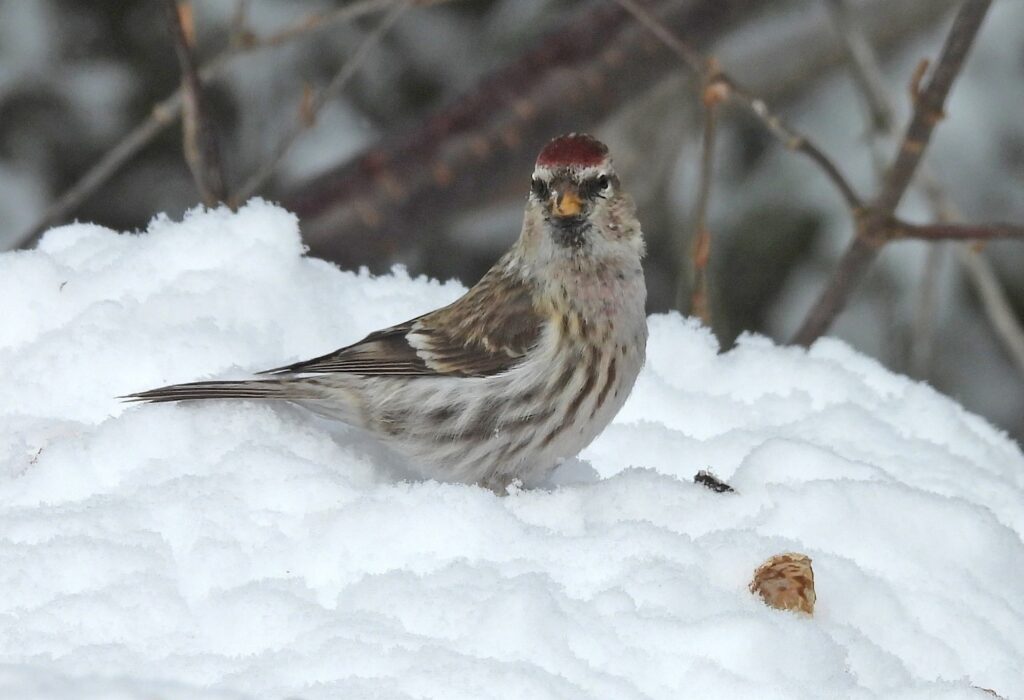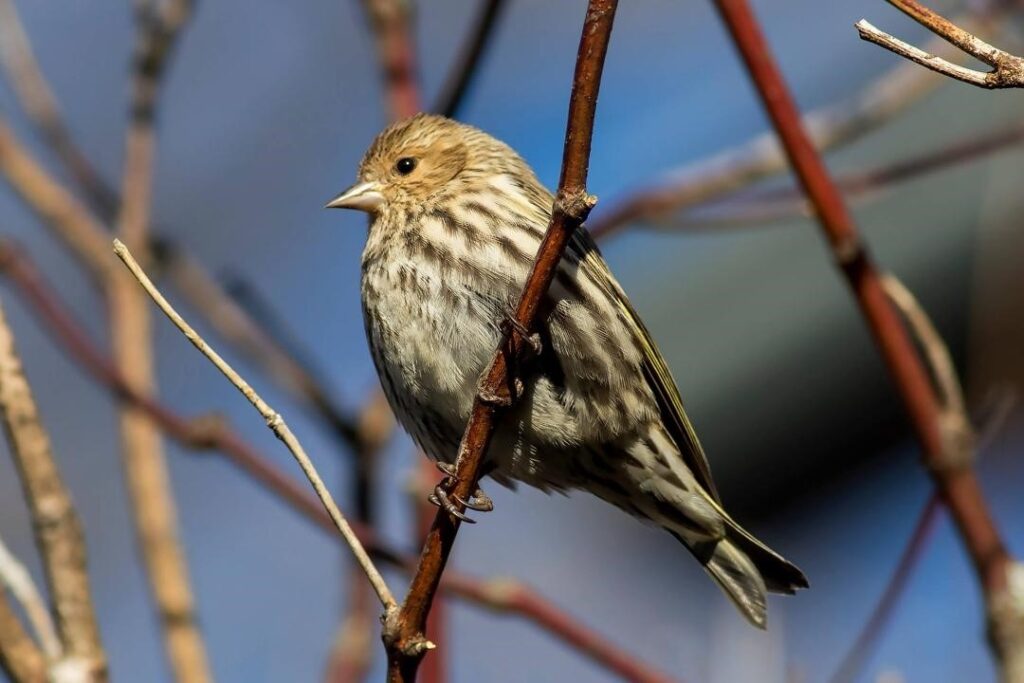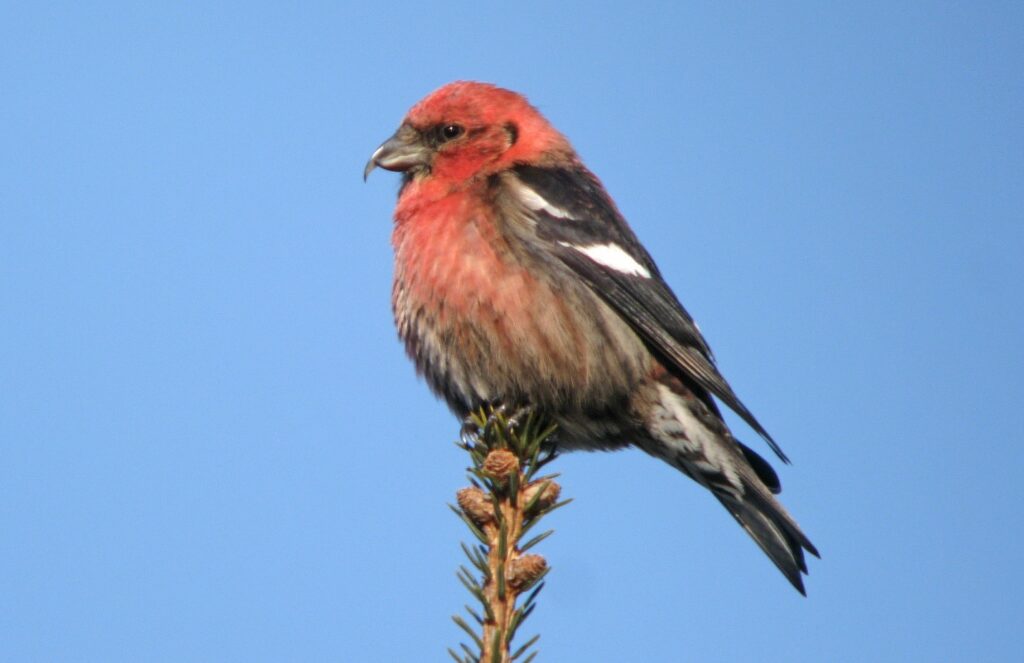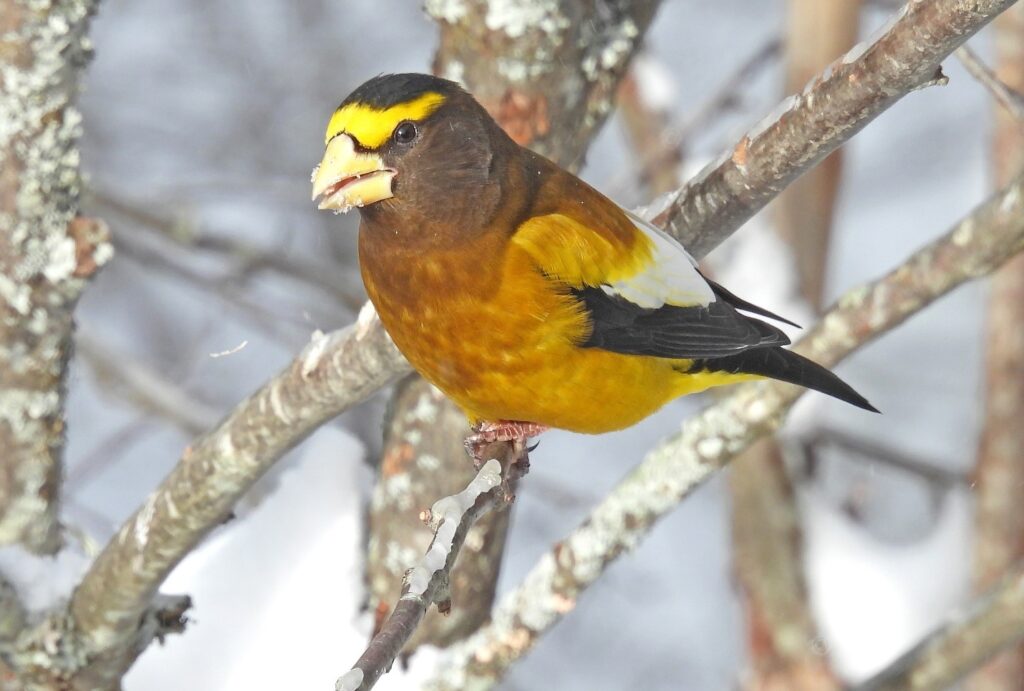On August 7th we lost Ron Pittaway the creator of the Winter Finch Forecast. We are all the better for his dedication and enthusiasm. Thank you, Ron.
By Forecaster Tyler Hoar
Photo Credits Jean Iron
GENERAL FORECAST 2023-24
This year’s Winter Finch Forecast will be a mosaic of movements differing in intensity and area across the species.
Forecasts apply mainly to Ontario and adjacent provinces and states. Three irruptive non‐finch passerines whose movements are often linked to finches are also discussed. To learn more, subscribe and follow the blogs, news, and updates at The Finch Research Network, and explore finch wanderings this fall and winter on eBird.
The boreal forest has generally a poor to below average cone crop this year that is bookended with bumper cone crops in Alaska and Newfoundland. Coastal areas to the south on the Atlantic and Pacific coasts have above-average cone crops, which seem to quickly drop in quality as one progresses inland. Large areas of the boreal forest across interior Canada have a very poor to poor cone crop. Only the Alder crop appears to be above average across the boreal forest.
The southern edge of the eastern boreal forest from Lake Superior eastward to the Atlantic coast and southward to the northeastern states has extensive areas of bumper Eastern White Pine crop. This area also contains an above-average deciduous tree seed crop and excellent fruiting crop.
INDIVIDUAL FORECASTS
PINE GROSBEAK

There is a widespread good crop of Mountain Ash berries from Lake Superior eastward. However, areas in Labrador appear patchy away from the coast. Most Pine Grosbeaks should remain in the eastern boreal forest with some flight into their traditional wintering areas in southeastern Canada and northern New England states.
West of Lake Superior, the Mountain Ash crop through the boreal forest westward generally appears below average with some areas of good crops. Areas in the upper Midwest states and cities in western Canada may see flocks of hungry grosbeaks searching for fruiting ornamental trees and well-stocked feeders with black oil sunflower seeds.
PURPLE FINCH

The movement of this species is one of opposite extremes this fall. Strong southward flights have been seen by mid-September at the Hawk Ridge Hawkwatch near Duluth, Minnesota. While to the east at Observatoire d’oiseaux de Tadoussac, Quebec, there has been very little movement. Northwest of Duluth into northwestern Ontario and Manitoba, the pit fruit and cone crop is below average, with reported areas of absence of food. While east of Lake Superior, the pit and deciduous fruit crops are above average and widespread.
In the east, many Purple Finches are expected to overwinter in southern Canada and the northeastern United States. Meanwhile from the upper Midwest states westward, there should be a stronger flight southward through the middle of the United States. Don’t be surprised if, as winter progresses, a late movement in January and February occurs into the Carolinas as eastern crops are depleted.
At feeders, they prefer black oil sunflower seeds.
COMMON AND HOARY REDPOLLS

Across the whole boreal forest, a good Alder crop has been reported. However, in the same areas, the spruce and birch crops are poor to below average. Expect a moderate flight south out of the boreal forest. Watch for redpolls on birches, in weedy fields and at bird feeders offering nyjer® and black oil sunflower seeds. Watch for Hoaries in flocks of Common Redpolls. See the link below for photos and identification marks of Common and Hoary Redpoll subspecies.
PINE SISKIN

Significant numbers of siskins have started to leave the boreal forest in mid-September, with 1000s reported daily at migration monitoring stations from Duluth, Minnesota eastward to Tadoussac Quebec. With the poor White Spruce crop in much of the boreal forest, there should be a moderate to possibly strong flight of siskins southward this fall. This entertaining species prefers nyjer® seeds in silo or sock feeders.
WHITE-WINGED CROSSBILL

With poor to absent cone crops reported across the interior boreal forest away from Alaska and Newfoundland, noteworthy movements of White-winged Crossbills have already occurred eastward to the Maritime Provinces and northeastern states since June. The excellent spruce crops in Alaska and Newfoundland have drawn many crossbills away from the interior. As remaining crossbills exhaust the below-average cone crop within the boreal forest, expect nomadic movements of small flocks of crossbills to come south during the winter in search of food. Thus, additional movements may be seen this winter into areas like southeastern Canada and the northeastern states, and westward into upper Midwest States and southern Manitoba as they look for suitable cone crops.
We may even see White-winged Crossbills away from forests, using heavy crops on planted native and ornamental spruces within urban environments.
RED CROSSBILL

As written above there is an excellent and widespread Eastern White Pine cone crop in place, and Type 12s have been around in their usual areas in the northeastern states since June-July.
During the middle of July however, Types 2 and 4 started invading the Great Lakes area, Ontario, Maritime provinces, and the northeastern states from across the continent, and there are growing subtle signs that Type 3 might be coming eastward as well. These types will all be hitting the bumper Eastern White Pine crop until it is exhausted (the White-winged Crossbills will probably hit it too). Birds will also be found in the remaining Red and White Spruce crops through fall and into early winter.
Once the calendar flips to 2024, will the Eastern White Pine crop be enough to hold birds and possibly initiate breeding, or will they be on the scramble looking here there and everywhere for food? As we get into the heart of winter, be sure to check your local patch of pitch, red, jack and Japanese black pines (aka the “hard pines”) for Type 12 and likely other types like large-billed Type 2 that will come south into coastal area pitch pine. Overall, expect crossbills to turn up in widespread areas in the east as winter progresses and turns into spring. Type 1 will be in the mix in interior areas as well.
The Red Crossbill types are usually impossible to identify without recordings of their flight calls. Recordings can be made with a smartphone and identified to type. Matt Young (info@finchnetwork.org) will identify types if you email him your recordings or upload them to an eBird checklist. Recordings uploaded to eBird checklists are deposited in the Macaulay Library. See the link below for Red Crossbill call types.
EVENING GROSBEAK

Eastward from Lake Superior is a bumper crop of fruit on Chokecherry, and above-average berry and deciduous seed crops. With this diverse and widespread food source available in the east, expect most birds to remain in the boreal forest and adjacent areas of Central Ontario, southern Quebec, the Maritime provinces, New England states, and New York this winter.
Evening Grosbeaks in northwestern Ontario westward should move out of the boreal forest, looking for feeders in towns or suitable food sources further south. Evening Grosbeaks in the mountains of western Canada may move southward as well.
At platform feeders, Evening Grosbeaks prefer black oil sunflower seeds. Evening Grosbeaks will look away from feeders for maple and ash trees still holding seeds. See the links section below for Evening Grosbeak call types eBird article and The Evening Grosbeak Road to Recovery Project.
THREE IRRUPTIVE PASSERINES
Movements of these three passerines are often linked to the boreal finches.
BLUE JAY
In eastern North America, the deciduous tree crop appears above average, so expect a small to maybe moderate flight this fall. With the poorer crops west of Lake Superior, there should be a moderate flight of Blue Jays southward.
RED-BREASTED NUTHATCH
Populations in the boreal forest should have small flights this year. Balsam Fir in the boreal forest, which is not infested with Spruce Budworms, has a good cone crop. This crop should hold many nuthatches closer to home this winter.
BOHEMIAN WAXWING:
Most Bohemians will likely stay in the north because native Mountain Ash berry crops are good, and other berry crops range from fair to good across the eastern boreal forest.
Lake Superior westward should see more widespread movements of waxwings. In the east, small numbers will probably arrive mid to late winter in traditional areas from Central Ontario eastward into the Maritime provinces and northern New England as winter progresses and food resources dwindle. If some move south, this species will forage on buckthorn and planted European Mountain Ash berries and ornamental crabapples.
Featured Image of Ron Pittaway credited to Jean Iron
We’re excited to also bring to you the the translation of the Winter Finch Forecast in French for the first time ever. Thanks to Alexandre Terrigeol and Jessé Roy-Drainville at Observatoire d’oiseaux de Tadoussac, Quebec.
FiRN is a nonprofit, and was granted 501c3 status in 2020. We are a co-lead on the Evening Grosbeak Road to Recovery Project, and have funded upwards of almost $10,000 to go towards research, conservation and education for finch projects in the last year plus. FiRN is committed to researching and protecting these birds and other threatened finch species like the Evening Grosbeak, Rosy-finches, and Hawaii’s finches the honeycreepers, and if you have been enjoying all the blogs and identifying of Evening Grosbeak and Red Crossbill call types (upwards of 20,000 recordings listened to), redpoll subspecies and green morph Pine Siskins FiRN has helped with over the years, please think about supporting our efforts and making a small donation at the donate link below.
Donate – FINCH RESEARCH NETWORK (finchnetwork.org)
Shirt Link
For a commemorative Winter Finch Forecast shirt where proceeds will go towards the study and conservation of finches and their habitats globally, see here: https://finchnetwork.org/shop
Feedercam
The Finch Research Network has a feedercam co-sponsored by Aspen Song Wild Bird Food, who is a member of Wild Bird Feeding Institute, and that will go live again in Caribou, Maine around November 1.
Please think about joining these Finch Research Network iNaturalist Projects:
Winter Finch Food Assessment Project/Become a Finch Forecaster: https://finchnetwork.org/the-finch-food-assessment-become-a-finch-forecaster
Red Crossbill North American Foraging Project: https://finchnetwork.org/crossbill-foraging-project
Evening Grosbeak North American Foraging Project: https://finchnetwork.org/evening-grosbeak-foraging-project
Finch Information Links
- Crossbills of North America: Species and Red Crossbill Call Types. https://ebird.org/news/crossbills-of-north-america-species-and-red-crossbill-call-types/
- Type 12 Red Crossbill: https://finchnetwork.org/type-12-the-old-northeastern-red-crossbill
- A Crossbill’s Guide to Conifers of the Eastern Forest: https://finchnetwork.org/a-crossbills-guide-to-conifers-of-the-northeastern-forest
- Finch Research Network with finch species information https://finchnetwork.org/
- Evening Grosbeak Call Types https://finchnetwork.org/species/grosbeaks/the-evening-grosbeak-project To support research and conservation for this species of conservation concern: https://finchnetwork.org/donate
- Evening Grosbeak Road to Recovery Project: https://finchnetwork.org/projects/the-evening-grosbeak-project
- Subspecies of Common and Hoary Redpolls – ID Tips and Photos.http://www.jeaniron.ca/2015/redpollsRP.htm
- Previous Winter 1999-2019 http://www.jeaniron.ca/WFFindex.htm
- 2020-2022 Winter Forecasts are available under the menu at https://finchnetwork.org/
I would like to thank the many birders, naturalists, biologists, and foresters whose tree seed reports allowed me to make this forecast:
Benny Albro (MA), Charmaine Anderson (NFLD, LAB, QC), Cathy Antoniazzi (Prince George BC), Denis Barry (Central and southern ON), Juliet Berger (Southeast MI), Anne Blondin (Pukaskwa National Park ON), Sarah Bonnett (Central ON), Ryan Brady (AK), Mark Calhoun (Central ON), Geoff Carpentier (Southern ON), Caleb Centanni (NY), Joe Cesolini (southern IL), Joan Collins (Adirondacks NY), John Corden (Flin Flon MB), Ian Cook northern ON), Ian Cruickshank (coastal BC), Michael Dawber (Rainy River District ON), Bruce Di Labio (eastern ON, NB, NS), Jessé Roy-Drainville (Gaspesie, Tadoussac QC), Konshau Duman (western WY), David Elder (Atikokan ON), Michael Ferguson (northern ON), Christian Friis (northwestern ON), Marcel Gahbauer (eastern Canada), Brody Gauthier (MA) Bill Gilmour (Presqu’ile Provincial Park ON), David Govatski (NH and VT), Amanda Guercio (northern AB, NWT), Glenn Hodgkins (ME), Mike Hudson (PA), Kyle Jones (VT), Nathan Kettler (NY), Rich Keith (southwestern MI), Susan Kielb (Upper Pennisula MI), Kent Ladell (Southwestern AB), Anne Marie Leger (northern NB), Nicolas Main (NY), Angela MacDonald (NS), Stuart Mackenzie (Nipissing District ON), Bruce Mactavish (NFLD), Brian McAllister (NY), David McCartt (NY), David McCorquodale (Cape Breton Island NS, PEI), Steven McGrath (NS), Stacy McNulty (Adirondack NY), Stephane Menu (northern ON), Eric and Anne Mills (NS), Alex Mills (Central and northern ON), Lily Morello (MA), Mark Peck (Haliburton, Hudson Bay lowlands ON), Brian Ratcliff (Lake Superior and Northern ON), Paul Riss (Manitoulin ON), Nathaniel Sharp (VT), Bill Sheehan (Northern ME), Jeff Skevington (eastern ON), Tim Spahr (MA), Carol Speck (Central ON), J. Staufer (ME), Will Sweet (MA, ME), Alexandre Terrigeol (Tadoussac PQ), Larry Therrien (western MA), Doug Tozer (Southern ON), Declan Troy (AK), Mary Beth Warburton (NY), Matthew Williams (UT), Quinten Wiegersma (Algonquin Park ON), Alexandra Windsor (Churchill MB), Toby Ye (Kelowna BC), and Matt Young (NY, MA).
Thank you to Charmaine Anderson, and Jean Iron for providing the photos. Thanks to Susan Hall, Jean Iron, Ryan Mandelbaum, Matt Medler, and Matt Young, for reviewing the forecast
25th Annual Winter Finch Forecast: The first was posted to the Ontbirds and Birdchat listservs in 1999.
Tyler Hoar Oshawa, Ontario. Finch Research Network, September 24, 2023.

